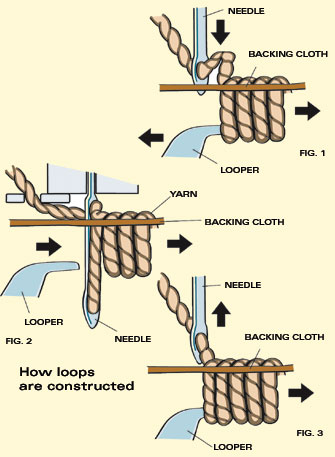home > carpet news > product knowledge > loop pile
Product knowledge:
Loop Pile
Reproduced with kind permission of Carpet and Flooring Review
Retail sales staff can never know too much when it comes to their products. With the help of experts from the flooring trade, we will be unraveling conundrums and demystifying the jargon which can leave us all stumped when customers delve deep for information. First up, Ali Hasan explains loop pile
What is a loop? It is essential to use the right yarn when making a loop carpet. This can be bulk continuous filament (BCF), which is synthetic – either nylon or polypropylene – or 100% woollen spun yarn. However, it is not possible to use a mixture of BCF and wool due to the construction of the yarn itself and the way it reacts to wear and performance. At Ryalux we prefer to use a top quality 100% woollen spun yarn as it is a staple and natural fibre, which responds well to the colouring process. In the early days of carpet manufacturing everything was done by hand and was a lengthy and laborious process. These days, there is ultra modern machinery which can create loop carpet with different gauge, yarn and designs. Costing up to £750,000 per unit, the machinery can be programmed to change the type of loop carpet it is producing within 30 minutes. This also makes it possible to re-programme the machinery from roll to roll. When the machines were threaded manually this process would have taken more than half a day. Ryalux has been using the tufting process since the 1960s. Treating the process like a recipe, to create a loop by hand we require the following ingredients; primary backing cloth, 100% wool yarn on an individual cone, a needle, a hook/looper and hard wearing jute backing. Below is a stepby- step guide on the construction of a loop carpet today. |
|
The production process The needle holding the yarn punches down through the backing fabric and, as it rises from its lowest position, the yarn is caught by a hook or looper below the cloth and held to form a loop. As the needle comes down for the second time, the hook moves backwards and the yarn loop is released. At the same time, the tufted fabric moves forward, helping to clear the loop from the hook. The needle descends again, a new loop is now made and the cycle is repeated. The construction of a cut pile is very similar to loop pile with the addition of a knife at each needle to cut the loop, creating open tufts of yarn. The hook faces in the opposite direction to the movement of the tufted fabric and an alloy steel blade, five to six inches long, cuts the yarn at the side of the hook in a scissor-like fashion. As the hook enters the new loop, the previous loop will slide along the length as a shared result of the movement of the hook and the forward movement of the fabric. As a new loop has started, the hook moves backwards to its home position and the knife blade moves up simultaneously to press against the hook and cut the loop. |
 |
Finishing touches After backing, the carpet goes through a seven point quality control inspection, which includes individuals checking the carpet by hand and correcting any slight flaws, to ensure it is delivered to the customer in a perfect condition. |
|
